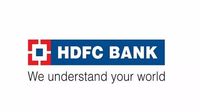On April 7, 2025, HDFC Bank shares experienced a significant decline, shedding 2.67% or ₹48.50, closing at ₹1,768.80. This drop comes amid growing concerns in the Indian stock market and the broader global economic context. As of 9:35 AM IST, the stock opened at ₹1,762.80 and peaked at ₹1,779.85 during the day. However, selling pressure soon took hold, pushing the stock down to a day low of ₹1,751.40.
The drop in HDFC Bank’s stock price reflects broader trends in the market, with investors responding to both domestic sectoral weakness and international market uncertainty.
Why the Decline in HDFC Bank Shares?
Several factors contributed to this sharp drop in HDFC Bank’s stock price. The main reasons can be tied to:
- Global Economic Concerns: With mounting fears of a potential global recession due to ongoing trade disputes and the possible impact of U.S. President Trump’s tariff policies, Indian markets are seeing a flight from riskier assets like banking stocks.
- Profit-Taking and Weak Sectoral Sentiment: HDFC Bank’s P/E ratio of 19.43 and dividend yield of 1.10% suggest that the stock has been relatively strong for most of the year, attracting investors. However, after a consistent rise, a phase of profit-taking was expected, which contributed to the sell-off.
- Broader Banking Sector Weakness: The banking sector as a whole has been under pressure, facing concerns regarding rising non-performing assets (NPAs) and slower credit growth. The Nifty Bank Index also posted losses in the previous session, reflecting the broader sectoral weakness. This naturally spilled over into the performance of stocks like HDFC Bank, which is a heavyweight in the sector.
Technical Analysis: Where Does HDFC Bank Go from Here?
From a technical standpoint, HDFC Bank appears to have hit resistance at the ₹1,800 level, as reflected by its recent price action. The 20-day exponential moving average (EMA) has also turned lower, further signaling a potential bearish trend in the short term. Immediate support levels for HDFC Bank can be seen around the ₹1,750 to ₹1,740 range, as these levels have acted as previous areas of buying interest. If the stock breaks below this zone, the next key support level would be around ₹1,700. On the upside, any attempt to recover will likely face resistance at ₹1,800.
Outlook for HDFC Bank
Despite the short-term volatility, HDFC Bank remains a strong player in the Indian banking space. It is one of the largest private sector banks in India with a robust customer base, diversified revenue streams, and a strong capital position. Investors will be keenly watching the bank’s Q4 earnings in the upcoming weeks. If the bank manages to show continued strong growth in its core businesses—especially retail banking, which has been a significant growth driver—the stock could bounce back in the medium to long term.
Additionally, HDFC Bank‘s ongoing efforts to digitize its services, expand its loan book, and build its market share in areas such as personal loans and SME lending will continue to be key drivers of growth.
Market Volatility and Caution for Investors
The stock market remains volatile, and this recent dip in HDFC Bank’s share price reflects broader trends in the market, with the Sensex and Nifty also experiencing significant declines in the early morning session. The Nifty 50 was down by over 900 points, as global trade tensions and domestic factors weighed heavily on investor sentiment.
Investors are advised to approach the market with caution and remain diversified. It may be an opportune time to look at stocks that are fundamentally strong but currently undervalued due to market-wide corrections.
Should You Buy, Hold, or Sell?
While HDFC Bank faces short-term headwinds, it remains fundamentally strong and is expected to recover once the broader market stabilizes. Long-term investors may view the current price levels as an attractive entry point. However, for short-term traders, it is advisable to monitor the technical levels and wait for signs of stabilization before making any major moves.
The banking sector's elevated credit-deposit ratio of 80.5% underscores the continued importance of deposit mobilization to sustain growth momentum. The affordable housing finance segment (HFCs) and gold loan providers (NBFCs) stood out as strong performers, with gold loan AUM growing approximately 29% year-over-year. Vehicle financiers (NBFCs) reported stable disbursements, benefiting from their fixed-rate loan portfolios, which saw about 20% year-over-year AUM growth.
However, mid-ticket mortgage loans (HFCs) and unsecured retail credit (banks/NBFCs) experienced slower growth as lenders exercised caution. The microfinance sector (NBFC-MFIs), while still facing elevated credit costs ranging from 9–34%, demonstrated improving collection efficiency—particularly in Karnataka, where March collections showed significant recovery. The microfinance sector could normalize by H2 FY26 if improving collection trends continue.
While challenges persist in deposit growth and select asset quality pockets, the sector’s fundamentals remain strong, supported by stable macroeconomic conditions and improving operational trends. The Nifty Financial Services Index is expected to reflect this resilience, with opportunities emerging in segments demonstrating sustainable growth and prudent risk management.
Motilal Oswal has a 'Buy' rating for HDFC Bank with a target of ₹2,050, representing a 12% upside from the last traded price (LTP) of ₹1,817. Loan growth for HDFC Bank is projected at 4%/10%/13% over FY25–27, with recent deposit growth of 14.1% year-over-year and a CASA ratio of 34.8%. HDFC Bank's GNPA is 1.4%, and NNPA is 0.5%, with steady credit costs of approximately 50 bps. RoA/RoE for HDFC Bank is expected to rise to 1.8%/14.2% by FY27, balancing disciplined growth with sustained profitability.
The stock market's performance on April 7, 2025, mirrored last week's rout on Wall Street, as escalating trade tensions between the world’s two largest economies spooked investors, triggering a swift flight from riskier assets amid growing fears of a global recession. The Nifty 50 opened with a 1,146-point cut, or 5% down, at 21,758—marking its biggest intraday loss since March 2020. Its peer, the Sensex, opened with a sharp decline of 5.19%, at 71,449. The broader markets, which are usually highly sensitive to volatile conditions, came under even more significant selling pressure, with the Nifty Midcap 100 index tumbling 7.26% to the day's low, while the Nifty Smallcap 100 index plummeted even more sharply by 10.15%.
All 50 constituents of the Nifty were trading with heavy losses, with Trent emerging as the top loser, slumping 15%. It was followed by other Tata Group stocks such as Tata Steel and Tata Motors, which slid 10% and 8.4%, respectively. Among sectoral indices, Nifty IT emerged as the worst casualty amid growing fears of a looming recession in the U.S. economy. The Nifty IT index crashed another 7% in today’s trade, following a 9% decline last week.
Meanwhile, the reciprocal tariffs and countermeasures have led economists to cut global growth projections for 2025 and increase the odds of the U.S. slipping into recession in 2025. Investment bank J.P. Morgan estimated a 60% chance of the global economy entering a recession by year-end, up from 40% previously.






